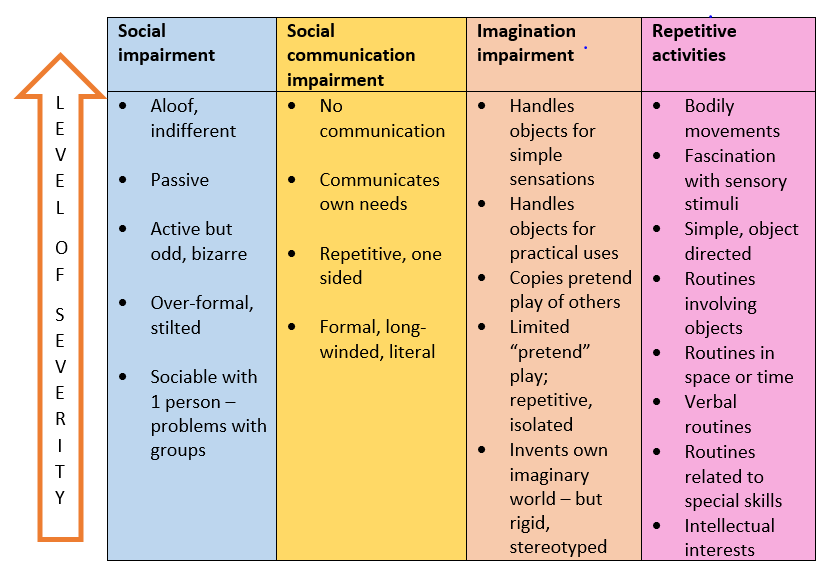What is autism?
Autism, or Autism Spectrum Disorder (ASD), is a condition that starts in early childhood and affects three main areas of development (often referred to as the triad):
- the way children socially communicate,
- socially interact with others, and
- the way they play, think and imagine, insist on routines or show repetitive behaviours.
ASD is a developmental disorder; its onset is during early development or even during pregnancy, and it affects the way children develop their thinking and abilities.
There is a wide range of symptoms in each of the three affected aspects of development mentioned above. Each symptom can affect individuals at a different level of severity. That is what makes individuals with ASD so unique and different from each other. The core behaviours or symptoms are present in early childhood, though some may not appear till a later age or a change of situation.
“IF YOU HAVE MET ONE PERSON WITH AUTISM, YOU HAVE ONLY MET ONE PERSON WITH AUTISM.”
“Spectrum” in ASD describes the range of manifestation in the triad and its variable association with a narrow range of activities and repetitive patterns of behaviours[i].

ASD with a severe level of impairments is often referred to as autism, classical autism or Kenner’s autism; the terms Asperger’s syndrome or high functioning ASD are often used for people with average or better language and intellectual abilities. Currently, we use the term ASD to describe the whole range of presentations and combine it with descriptions of abilities or impairments in the main aspects of function to provide a meaningful profile of the child’s abilities and function.
Do people with ASD have some other difficulties as well?
People with ASD may have an intellectual or learning disability, which affects all aspects of their function and life – from learning to self-care and living independently. The degree of intellectual disability varies widely from person to person, some requiring a lot of support while others achieving good academic and/or vocational success with minimal support.
Like other developmental disorders, people with ASD often have other co-existing conditions e.g. ADHD and atypical patterns of movement and posture, eating / drinking / sleeping, mood and behaviour. The needs of a person with ASD depend on their profile of symptoms on different dimensions and coexisting conditions than from simply assigning a categorical diagnosis.
Can a person have some features of ASD but not a full diagnosis?
There is a spread or continuum of developmental abilities amongst people e.g. some are weak or strong in language, play, perspective taking or social reciprocity. Some features of ASD are also seen in people with language and/or learning difficulties and, sometimes, in close relatives of a person with ASD. However, those with a diagnosis of ASD have a triad of impairment as described above[ii],[iii].
What causes autism?
Autism is a genetic condition. Parenting, diet or social circumstances do not cause autism. It would not be correct to blame one or the other parent for the child’s condition. Genetic changes often appear de novo in the child. Several genes (estimates range from 200-1000) interacting with each other and with the environment create a disruption of growth and connectivity in the developing brain altering its structure and function. This alters the child’s patterns of attention, perception and learning, and compromises their ability to learn from the environment. Emerging altered behaviour patterns further restrict their social learning opportunities creating longer-lasting impairments[iv]. Further details about the genetic aspects can be viewed here: Genetics of autism.
How common is ASD?
As parents and professionals are getting better at recognising the ASD its numbers, or prevalence, are rising. Current estimates range from 1 in 100 to 1 in 68 people having ASD.
Can autism be cured?
There is no medical or other cure or treatment for autism. However, there is lot that can be done to help a child with ASD improve and learn. With the right approach and help all children with ASD can improve. All children with ASD can grow and learn well in an informed and supportive environment. Many children with ASD achieve good academic or vocational success and grow up to lead a fulfilling life.
[i] Wing, L., & Gould, J. (1979). Severe impairments of social interaction and associated abnormalities in children: Epidemiology and classification. Journal of autism and developmental disorders, 9(1), 11-29.
[ii] Klin, A., Jones, W., Schultz, R., Volkmar, F., & Cohen, D. (2002). Defining and quantifying the social phenotype in autism. American Journal of Psychiatry, 159(6), 895-908
[iii] Constantino, J.N. & Todd, R.D. Autistic traits in the general population: a twin study. Arch. Gen. Psychiatry 60, 524–530 (2003).
[iv] Jones, E. J., Gliga, T., Bedford, R., Charman, T., & Johnson, M. H. (2014). Developmental pathways to autism: a review of prospective studies of infants at risk. Neuroscience & Biobehavioral Reviews, 39, 1-33.
AUTISM: Awareness and recognition <PREVIOUS PAGE NEXT PAGE> How do we identify a child with ASD?
